Project Log: Friday, September 10, 2010
My immediate goal over the coming days, as time allowed,
was to remove everything from the boat that was going to
be removed. So I continued in the cabin, this time
focusing on the head and forward cabin.
The head still contained a number of little bits of
hardware, a soap dish, a couple handrails, and old
cleats that had once supported various panels or
whatever. I removed all these pieces, along with
the remaining nasty vinyl from beneath. Then, I
unscrewed the molded head sole/shower pan and removed
it.
Beneath the pan was more of the expected silt and
debris, plus an oven mitt, which I'd no idea how it
might have managed to end up beneath the head.
Later, I'd clean this mess out, and I also planned to
remove the three through hulls and patch the holes, as I
like a fresh start when it comes to through hull
fittings--both for layout and to ensure quality
installation. |
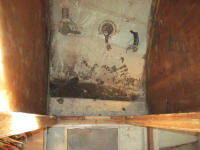
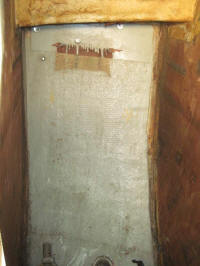
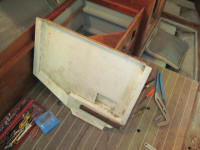 |
Next, I removed a series of old shelf cleats and
hardware (hooks and curtain rods) from the hanging
locker opposite the head, and removed the center
bulkhead, which was secured with light tabbing against
the hull and came out easily. Whatever our plans
for this locker space, they didn't include reusing any
of the old shelves and dividers. |
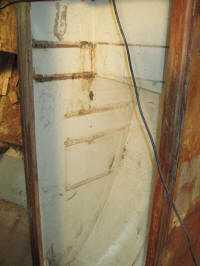 |
The anemic tabbing that had once secured (in a manner of
speaking) the old galley bulkhead came out with minimal
persuasion from a 5-in-1 tool. Sorry for the
blurry picture. |
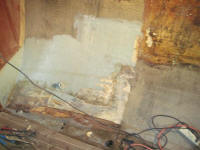 |
In the saloon, I removed remaining cleats, light
fixtures, wires, and anything else that was still
attached to the various bulkheads, leaving clean
surfaces behind. I planned to cover the bulkheads
with new material, as the original teak veneer was in
poor condition, scarred and full of holes from old
hardware. Plus, I wanted a cherry-trimmed
interior. I continued to uncover more silt
that even my relatively thorough cleaning a couple weeks
earlier had missed, reinforcing my belief that removing
as much as possible from the interior was important. |
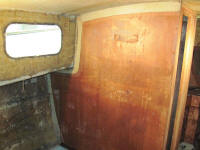
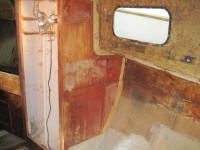 |
We planned to reconfigure the forward cabin into a
full-width berth, with no walk-in space or divider.
Also, the original design left much to be desired in
terms of storage space and access to same, plus
overabundant wasted space--something one can't afford to
have in a 30-footer.
So during
what remained of the day for me, I removed the teak trim
(reserving all solid teak for some future use), and all
the remaining structure aft of the half bulkhead holding
the water tank in place. I removed some tabbing
that had helped secure the edges of the original v-berth
platform, the front panels that had formed the "v"
(secured only with a few screws and easy to remove
intact), and the intermediate shelving.
The new-found space, which would eventually be hidden
beneath the new full-width berth, would provide for
additional tankage, sewage treatment placement, and bulk
storage--the details of which all would be determined
later. |
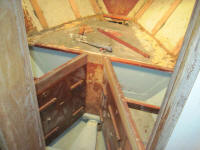
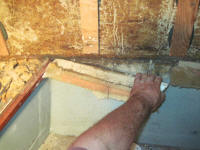
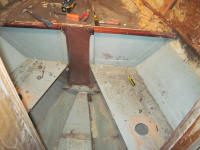
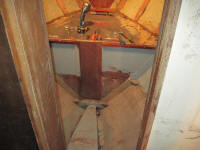 |
For the moment, I left the last bulkhead in place, the
one aft of the water tank. I wasn't yet sure what
to do with the tank. At a minimum, I wanted to
clean it out, which would mean installing some access
ports in the top. I hoped the tank would be
salvageable, but wouldn't know till I could get a look
inside. In any event, I doubted the tank would fit
through the opening into the forward cabin, though it
might be possible to twist it out in one piece.
While I contemplated the tank's ultimate fate, I left
the bulkhead in place, though I cleaned off some really
ugly excess foam--which had been used to secure the tank
in place--from the top of the tank, amazed that such
ugliness could not only depart the factor, but also
remain untouched all these years. |
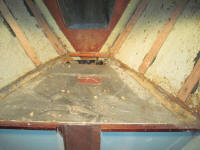 |
Of similar unacceptable ugliness--not to mention
insufficient future functionality--were the plywood
strips someone in the past had installed along the
inside of the hull in the forward cabin (the "ceiling"
in proper nautical nomenclature). These plywood
supports were intended as screw-accepters for a wooden
ceiling, the material for which came with the boat
(though I didn't like the material and planned to use
something else when the time came). I could have lived
with the ugliness of the plywood, knowing that it'd be
covered later, but the support strips weren't evenly or
symmetrically applied, which would mean that screws
holding the ceiling strips in place would have to
include misalignment and asymmetry--unacceptable.
Also, I wasn't sure how the previous person had intended
to handle the four round ports installed in the
hull--two per side--but I had a method in mind, and the
little blocks surrounding each port wouldn't fit in with
that plan. So, at some point soon I'd have to
remove all these support strips--but not today. |
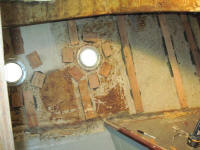
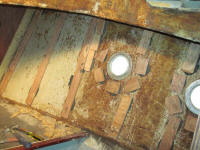 |
To round out the day, I removed the final bits of trim
from around the chainlocker bulkhead. I would
have liked to continue, but I had a mid-day appointment
which, despite being a short appointment, ate up the
remainder of the day with travel time. |
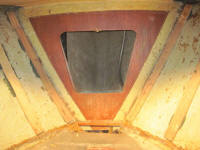
|
Total Time Today: 2.75 hours
|
< Previous |
Next > |
|
|
















